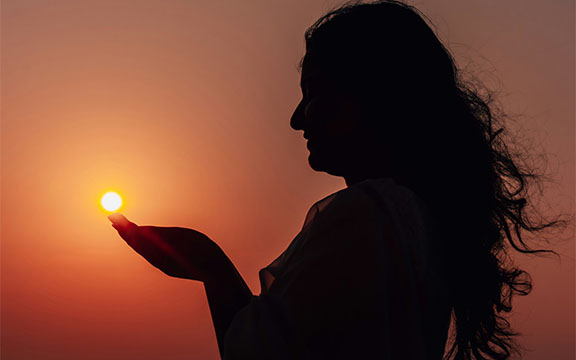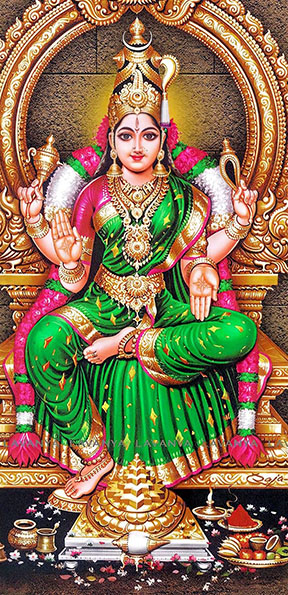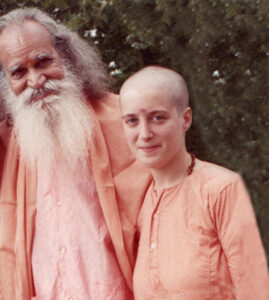
Photo by Jyothisha, courtesy of Unsplash.
In the previous chapter of this journey tracing the spiritual legacy of Swami Satchidananda, we touched on the mystical experience he had while meditating at the samadhi shrine of Siddhar Bhogar in Palani. It was there—surrounded by the silent vibrations of Tamil Nadu’s ancient Siddha wisdom—that Ramaswamy, as he was then known, received an inner blessing and initiation into the bija (sacred seed) of the Divine Mother Bhuvaneshvari. That single moment would ripple outward for decades to come.
The Gentle Power of the Heart
Among the Dasha Mahavidyas—the Ten Great Wisdom Goddesses of Tantra—Bhuvaneshvari is perhaps the most gentle and spacious. While Kali and Bhairavi blaze with fierce transformative energy, Bhuvaneshvari is the vast and welcoming sky in which those fires can burn. She is the field of the possible, the space in which grace unfolds. Her domain is akasha, space itself—the ether that connects all, pervades all, and holds all in Her loving presence.
This is no passive background, however. In the Tantric view, Shakti is not merely supportive; She is the supreme power behind creation. Bhuvaneshvari is the Shakti who embodies the blueprint of existence. She does not merely energize creation—She becomes it.
For Swami Satchidananda, whose own path was deeply steeped in devotion, compassion, love of all creation, and equanimity, Bhuvaneshvari’s essence as the Queen of the Universe resonated on a profoundly personal level. Her bija was not just a mystical syllable. It was a sound-form of the Divine Mother—an embodiment of grace, beauty, and the vast, loving awareness that he strove to manifest in his own life.
Bhogar and the Heart-Centered Tantra
Siddhar Bhogar, whose legacy permeates Tamil Shaiva Tantra, is revered not only as a master of Kundalini awakening but also as a teacher of profound devotional subtlety. His system emphasized three essential tools for spiritual awakening: pranayama, mantra, and symbolic visualizations—especially yantras.
While many lineages focused on intense austerity or shock techniques to awaken the dormant Kundalini, Bhogar introduced a system in which the feminine current, the Shakti, was approached with reverence and beauty. His Ishta Devata—his chosen deity—was Bhuvaneshvari, and Her yantra and mantra played a central role in his sadhana.
When Ramaswamy received the blessing and initiation at Bhogar’s shrine, it was not simply a personal experience; it was a transference of lineage, a silent passing of the torch from the ancient Siddhar to a modern spiritual master.

Artist rendering of the Goddess Bhuvaneshvari.
Who Is Bhuvaneshvari?
The name Bhuvaneshvari means “Queen of the Worlds.” She is the sovereign Goddess of bhuvana, the phenomenal universe. Not coincidentally, She is also deeply linked with maya—not as delusion, but as the sacred measure through which the formless takes form. She is the very matrix of manifestation.
In Sri Vidya and Tantric traditions, Bhuvaneshvari is an aspect of Sri Lalita Tripurasundari, the most exalted of the Goddesses. She is one of the original powers through which all other Goddesses arise. She is described in the Lalita Sahasranama as the ruler of the 14 worlds and the sustainer of both land and sea. Her form is that of radiant beauty: vermilion-hued like the dawn, with flowing hair, three compassionate eyes, and a smile that dispels all fear.
She holds a noose (to draw the devotee inward), a goad (to remove obstacles), and blesses with both fearlessness and boons. She is seated on a jeweled throne, surrounded by the guardians of the directions, in Her resplendent realm of Manidvipa—a mystical island of light and bliss said to be self-created by Her divine thought.
The Power of Bhuvaneshvari’s Bija
The bija is the sound-form of the Divine Mother in her most expansive, inclusive aspect. As such, the bija was not just a blessing—it was a direct tuning of the soul to the Infinite. At once accessible and infinitely subtle, this bija encapsulates the full journey from separation to union.
This bija is the heart-sound of Bhuvaneshvari. It is often called the Shakti Pranava—the feminine counterpart to Om. While Om vibrates with the expansive force of pure Being, Her bija resonates as the intelligent, compassionate power of manifestation. It is the sound-body of the Goddess Herself.
The bija does not have a literal meaning; rather it creates a vibrational field. As such, it awakens the heart chakra (anahata), the inner space of the Divine. This is why it is often called the mantra of the heart—not just the physical organ, but the seat of Divine Presence within each being.
An Embrace for the Modern Seeker
In a world that increasingly values stimulation over stillness, and information over inner transformation, this bija is a call back to the heart. Swami Satchidananda’s embrace of Bhuvaneshvari’s bija was not merely doctrinal—it was deeply personal. In his many writings and talks, he often spoke of the need to live from the heart, to cultivate expansive awareness and equanimity. The path of Integral Yoga was designed not to shock the system into awakening, but to gently reveal one’s inherent peace.
This reflects the very nature of Bhuvaneshvari. Her grace is not dramatic, but vast. Her power is not in domination, but in spacious inclusion. She is the backdrop of all experience—the great canvas on which the universe paints its luminous dance.
For aspirants, repetition of the bija becomes more than a spiritual practice—it becomes a way of attuning to this universal rhythm. The bija doesn’t pull one away from the world; it sanctifies one’s place within it. It opens the heart, not only to the Divine, but to all beings.

Photo by Quang Nguyen, courtesy of Pexels.
Bhuvaneshvari and the Cosmic Dance
The Tantras often pair Bhuvaneshvari with Kali. While Kali governs Time—destroying, transforming, and revealing—Bhuvaneshvari holds Space, the great expanse in which all of life unfolds. Her presence is the compassionate vessel in which even our struggles find room to breathe. It is She who whispers: there is space for your growth, your pain, your joy, and your awakening. In Her vastness, there is acceptance. In Her beauty, there is affirmation of this world—not as a trap to escape, but as a sacred play in which we can realize our true Self.
The Living Legacy
To truly live this bija is to allow that sound to reverberate in every moment, every breath, and every encounter. It is to carry the space of the Divine Mother in the heart, and to radiate that space in the world.
The Goddess Bhuvaneshvari—her mysticism hidden in scriptures yet revealed in silence—continues to guide seekers not only through mantra japa, but through the example of great sages like Swami Satchidananda. His life was Her life. His compassion was Her grace. His path was Her spacious embrace. In this sacred sound may each of us rediscover the vastness within. And in that rediscovery, may we become, like him, gentle torches of Her eternal light.
About the Author:
 Swami Premananda, Ph.D. is a senior disciple of Sri Gurudev Swami Satchidananda and served as his personal and traveling assistant for 24 years. Her interest in the study of the spiritual roots of the Integral Yoga tradition and lineage was inspired over many years of traveling with Sri Gurudev to the various sacred sites throughout India that are a part of this tradition. She also undertook a 2-year immersion into the nondual Saiva Yoga Siddhar tradition that is at the heart of Sri Gurudev’s spiritual roots. She further studied the history, sacred texts, and teachings of Advaita Vedanta and Tamil Saivism including the Siddhars, bhakti poet saints, as well as the spiritual luminaries who lived in the 19th – 20th centuries and who inspired Sri Gurudev, such as Sri Ramana Maharshi, Swami Ramdas, and Swami Vivekananda. She serves as editor of Integral Yoga Magazine, Integral Yoga Publications; senior archivist for Integral Yoga Archives; and director of the Office of Sri Gurudev and His Legacy.
Swami Premananda, Ph.D. is a senior disciple of Sri Gurudev Swami Satchidananda and served as his personal and traveling assistant for 24 years. Her interest in the study of the spiritual roots of the Integral Yoga tradition and lineage was inspired over many years of traveling with Sri Gurudev to the various sacred sites throughout India that are a part of this tradition. She also undertook a 2-year immersion into the nondual Saiva Yoga Siddhar tradition that is at the heart of Sri Gurudev’s spiritual roots. She further studied the history, sacred texts, and teachings of Advaita Vedanta and Tamil Saivism including the Siddhars, bhakti poet saints, as well as the spiritual luminaries who lived in the 19th – 20th centuries and who inspired Sri Gurudev, such as Sri Ramana Maharshi, Swami Ramdas, and Swami Vivekananda. She serves as editor of Integral Yoga Magazine, Integral Yoga Publications; senior archivist for Integral Yoga Archives; and director of the Office of Sri Gurudev and His Legacy.

